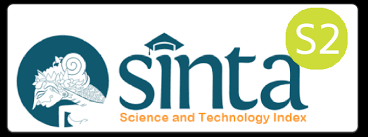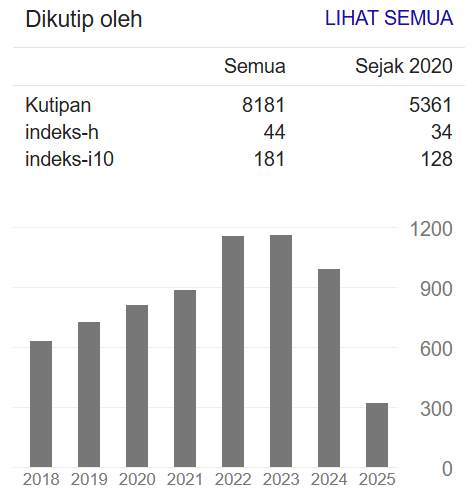EFEKTIVITAS TABLET FE DAN BISKUIT TEPUNG BIJI SALAK DALAM MENINGKATKAN ASUPAN ZAT BESI, ZINC DAN VITAMIN C PADA REMAJA PUTRI DENGAN ANEMIA
DOI:
https://doi.org/10.34011/jmp2k.v34i4.1935Keywords:
anemia, iron, salak seed flour biscuits, vitamin C, zincAbstract
Iron nutritional anemia is a prevalent health issue among adolescent girls. Several factors contribute to anemia in this demographic, including inappropriate growth for age, poor nutritional intake, unhealthy food habits, inadequate or excessive physical activity, irregular menstrual cycles, and lack of nutrition knowledge. To address this, the government has implemented supplementation programs with iron tablets. Additionally, utilizing local foods rich in iron presents a potential complementary strategy.This study aimed to analyze the effect of salak seed flour biscuits (TBS) on the intake of iron (Fe), zinc (Zn), and vitamin C in anemic adolescent girls.This research was designed as a randomized controlled trial (RCT) with a pretest-posttest control group design. The study involved 33 anemic adolescent girls from Indramayu Regency. Data collection methods included interviews using structured questionnaires, 24-hour food recall forms, and anthropometric measurements of body weight and height. Data were analyzed using one-way ANOVA, followed by Bonferroni post hoc tests.The results indicated that the administration of TBS biscuits significantly increased the intake of Fe, Zn, and vitamin C in all groups. Notably, TBS biscuits containing 4.17 mg of Fe per 100 g showed the highest increase in nutrient intake. Over a 60-day period, these biscuits significantly boosted the intake of Fe, Zn, and vitamin C in anemic adolescent girls.The study concluded that TBS biscuits are an effective intervention for increasing the intake of essential nutrients in anemic adolescent girls. The inclusion of such fortified local foods can be a valuable addition to existing anemia prevention programs.
References
L. M. Fiorito, A. K. Ventura, D. C. Mitchell, H. Smiciklas-Wright, and L. L. Birch, “Girls’ Dairy Intake, Energy Intake, and Weight Status,” J Am Diet Assoc, vol. 106, no. 11, pp. 1851–1855, Nov. 2006, doi: 10.1016/j.jada.2006.08.003.
D. Briawan, A. Sulaeman, E. Syamsir, and D. Herawati, “Efikasi Fortifikasi Cookies Ubi Jalar untuk Perbaikan Status Anemia Siswi Sekolah,” Majalah Kedokteran Bandung, vol. 45, no. 4, pp. 206–212, Dec. 2013, doi: 10.15395/mkb.v45n4.166.
D. Indarto et al., Makanan Tambahan Anemia dari Tepung Biji Salak Pondoh. Nas Media Pustaka, 2023.
D. E. Murni and Y. Nurhayati, “Hubungan Pengetahuan Ibu Hamil Tentang Anemia, Status Gizi Ibu Hamil Dengan Kejadian Anemia Di Desa Kenanga Kecamatan Sindang Kabupaten Indramayu,” Jurnal Kesehatan Indra Husada, vol. 6, no. 1, pp. 39–45, 2018.
P. I. Hartaningrum, N. K. Sutiari, and L. A. Dwijayanti, “Hubungan antara Asupan Gizi dengan Status Gizi Remaja Putri,” Jurnal Kesehatan, vol. 12, no. 3, pp. 411–418, 2021.
K. RI, “Petunjuk teknis pemberian makanan tambahan (balita-ibu hamil-anak sekolah),” Kementerian Kesehatan RI, 2017.
poppy Wijayanti, “Pengaruh Dosis dan Lama Pemberian Jeli Kombinasi terhadap Kadar Hemoglobin, Indeks Eritrosit dan Asupan Nutrisi pada Remaja Putri Anemia di Kabupaten Banyuwangi,” Universitas Sebelas Maret, Surakarta, Jawa Tengah, 2018.
S. Sastroasmoro, “Dasar-dasar metodologi penelitian klinis,” 2022.
J. Charan and T. Biswas, “How to Calculate Sample Size for Different Study Designs in Medical Research?,” Indian J Psychol Med, vol. 35, no. 2, pp. 121–126, Apr. 2013, doi: 10.4103/0253-7176.116232.
P. Wijayanti, Y. L. R. Dewi, and D. Indarto, “Consumption of Jelly Combination of Salacca Seed (Salacca zalacca) and Moringa Leaves Flour (Moringa oleifera) on Hemoglobin level in Female Adolescents with Moderate Anemia,” Indonesian Journal of Medicine, vol. 6, no. 3, pp. 307–314, 2021.
W. H. O. Guideline, “Daily iron supplementation in adult women and adolescent girls,” Geneva: World Health Organization, vol. 33, 2016.
S. Fikawati, A. Syafiq, and A. Veratamala, “Gizi anak dan remaja,” 2016.
W. Y. Perdana and D. J. Jacobus, “Hepcidin dan Anemia Defi siensi Besi,” Cermin Dunia Kedokteran, vol. 42, no. 12, pp. 919–926, 2015.
C. A. Sholicha and L. Muniroh, “Hubungan asupan zat besi, protein, vitamin C dan pola menstruasi dengan kadar hemoglobin pada remaja putri di SMAN 1 Manyar Gresik,” Media Gizi Indonesia, vol. 14, no. 2, pp. 147–153, 2019.
T. A. Utama, N. Listiana, and D. Susanti, “Perbandingan zat besi dengan dan tanpa vitamin c terhadap kadar hemoglobin wanita usia subur,” Kesmas, vol. 7, no. 8, pp. 344–348, 2013.
M. A. Dijkhuizen, F. T. Wieringa, C. E. West, and S. Martuti, “Effects of iron and zinc supplementation in Indonesian infants on micronutrient status and growth,” J Nutr, vol. 131, no. 11, pp. 2860–2865, 2001.




